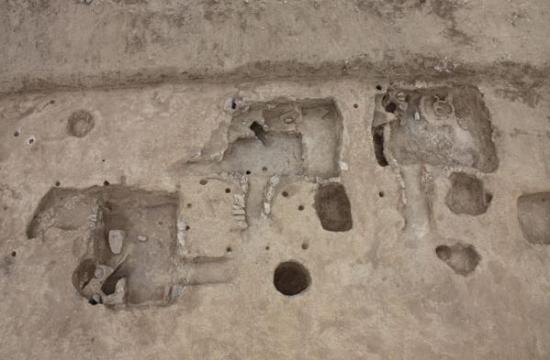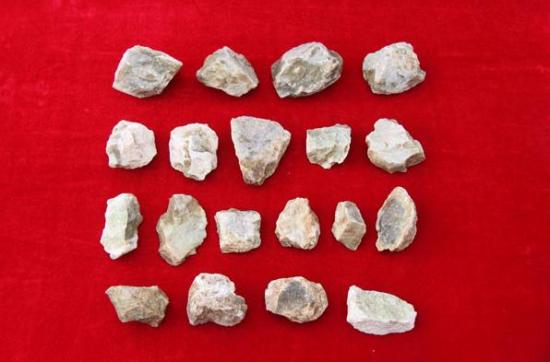Chinese Institute of Archaeology
Source - http://www.kaogu.cn/en/detail.asp?ProductID=4170
The Mazongshan jade mine site is located in the HeyanHujingBaoer Grassland, 20 km northwest away from the Mazongshan town, Subei County. During October and November in 2011, Gansu Institute of Archaeology excavated the site based on the investigation happened in 2007 and 2008. The excavation was carried out in a 150 square meter area and obtained a great achievement. In order to further disclose the settlement pattern of the Mazongshan site, Gansu Institute of archaeology carried out the second excavation at the site during October and November 2012. This excavation laid out the squares near the excavation area of 2011 in the first locale and covered 700 square meters. There were 49 features discovered in all, including 38 ash pits, 9 house remains, 2 stone terrace base remains and over a thousand of artifacts.

The house remains discovered in this excavation could be classified into two styles: ground buildings and semi-subterranean buildings.
The ground buildings could be classified into two types. Type A is upright post buildings on ground, in which the wall body could not be seen. F6 was the representative of this type, but it only had post holes and partial activity surface existed, and it is difficult to confirm its concrete structure at present. No collapsed walls were seen on the ground and only partial grey-white floor was remained. In addition, burned traces could be seen in some parts.
Type B is walled buildings on ground. F8 was the representative of this type. It was rectangular in plain with a 430-450cm length in east-west direction and 270cm width in south-north direction. It consisted of main buildings and auxiliary buildings and no door way was found. The main buildings consisted of stone walls, earth terrace, stove, pits and activity surface. The auxiliary buildings were located to the west of the main buildings and were two pits inter-connected with a stone wall in the middle. The activity surface was remained well and was paved with about a 4cm thick gray-yellow earth with a thin layer of ash remained on the surface.
The semi-subterranean buildings were the main building style at the site and could be classified into four types. Type A was large in size and arranged in order. F1 and F2 were the representatives. F2 sit in west and faced east in slightly southeast –northwest direction. It was square shaped in plain and mainly consisted of post holes, door way and main room. There were 7 post holes located in both south and north sides of the house. There were 3 post holes in the north row and 4 holes in the south row. In addition, there were 2 door-ways, which were located in the south and north sides of the east part of the house, and were shallow square pits in plain. The main room was rectangular with a 300-352cm width in east-west, 584cm length in south-north and 100-110cm depth. The main room consisted of stone walls, stove, earth terrace, operation pits and activity surface. The stove was located in the southwest and was like a fan in shape.
Type B was small in size and arranged in order. F3, F4, F5 and F9 were the representatives. F3 sit in west and faced east, consisting of post holes, door way, storage pits, earth terrace, operation platform (pits), stove. The main room was almost square in shape and 344 cm in south-north, 256cm in west-east and 52-80 cm in deep. There was stone paved on the edge of the pits. The door way was located in the south side of the east part of the house and was shallow rectangular pits in an incline shaped from east to west. There were 2 storage pits. No.1 was located in the north side of the east part outside the main room and almost symmetric to the door way. No.2 was located in the southeast part inside the main room and connected the door way in the east and stove in the west. The stove was located in the southwest corner of the main room and paved with earth and stone. It was like a fan in shape but the northwest part was destroyed. A circle-shaped hearth had a chimney up along the southeast corner of the main room. The chimney was circle in shape and was pave with earth. The operation platform was located in the north part of the stove and was paved with earth in a circle shape in plain. In addition, there were 3 post holes discovered in the south part outside of the house.
Type C is simple in structure. F7 was the representative. F7 was near oval shape in plain and was about 470cm in south-north, 320cm in west-east. No door way was discovered. Four post holes were discovered surrounding the pit. An irregular square ash pit was discovered at the southeast bottom of the house and might have been the auxiliary buildings of F7.
Type D consists of varied pits. F10 was the representative. F10 mainly consisted of three pits--H39, H40 and H41. H39 was irregular in structure and there were a large number of rocks accumulations in the west. H40 was located in the southeast corner of H39. It was circle in plain, tubbiness in section and there was a stove pit paved with earth and stone at the bottom. At the bottom of the pit, there was an about 10cm thick floor surface, on which heaped up a large number of stone debris and rocks. Burned traces on the floor and some stones could be obviously seen. H41 was located in the northwest part of H39, circle shaped, bag shaped in section. Inside the pit, there piled up a large number of jade materials. In terms of the plain structure and the artifacts unearthed from different parts of the features, H41 was a storage pit; H40 was a stove pit and H39 was a production place.

The unearthed artifacts include pottery shards, bronzes, golden pieces, irons tools, lithic tools, jade materials, agate cups, rotten woods, bone artifacts, animal bones, animal excrement and so on. The pottery shards dating to Han dynasty and the Shanma Culture coexist. The large number of jade material had partially been polished. Lithic artifacts mainly included stone hammers, axes, choppers and gravel, etc. The discovered iron fragments included bronze-iron artifacts. The bronze mainly had arrow heads and a spade coin. Other artifacts were difficultly identified. There were crucible fragments discovered on the ground of F3.
Through the investigation and excavation, the boundary and settlement pattern of the Mazongshan site were primarily known. There were minery, workshop district, defense installation district discovered at the first locale. The corresponding features mainly included mine pits, workshop remains and defense buildings such as lookout post. They could be dated from the Warring States period to Han dynasty.
The Mazongshan jade mine site is the largest-scale early industrial site discovered in the northwest China so far. It supplied significant materials for us to understand the life condition and social organization and management at that time and so on, while it showed the mine layout pattern. Also it laid foundations for further understanding the mineral composition of the Mazongshan jade mine, the geological characteristics of mineral deposit, gemological characteristics and the study on the circulation of the Mazongshan jade mine. (Translator: Zhai Shaodong)